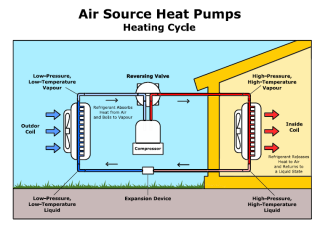Air-Source Heat Pumps

Air-source heat pumps move heat from outside to inside (in heating mode) or indoors to outdoors (in cooling mode). Heat pumps have an outdoor unit that contains a compressor and fan. You usually see them outside, placed above the ground. Heat pumps are now advanced enough to meet all your heating & cooling needs, even in our very cold New England winters and hot summers.
They are at least three times more efficient at heating than systems that burn fossil fuels and provide whole home cooling so you can upgrade from your inefficient window AC or dated central cooling system.
Click the image to view and download OER's Residential Guide to Air Source Heat Pumps.
How they work

Heat pumps work by moving heat from one space to another through a similar process to that of your refrigerator. A closed loop of refrigerant combined with a compressor and an expansion valve absorb heat in one location and release it in another. This process can be used to cool a space or heat it. Because heat pumps move heat rather than burn fuel to release it, they can be extremely energy efficient. If the electricity used to power a heat pump comes from carbon neutral sources (ex. wind or solar power), then no greenhouse gases are emitted to heat and cool a home. Further information can be found here
How to Get One
If you are interested in an air source heat pump, we encourage you ask several contractors about pricing and options. This list of contractors are some of the local contractors who are approved to install energy efficient systems. There are also rebates and interest free loans available for heat pumps, to those who are eligible.
2 Types of Air Source Heat Pumps
Your contractor will help you decide between a “mini-split” or a “ducted” heat pump system, or a combination of both. The mini split heat pump connects the outdoor unit(s) with indoor units on the wall, ceiling, or floor, like the one pictured below. The ducted system brings warm or cool air in from the outdoor unit through ducts and vents, which many homes already have.


Weatherization First!
An essential step before installing a heat pump is to have your home weatherized, which insulates it and makes it better sealed, so that your home stays the temperature you want it to. This means your new system won’t have to work as hard to heat and cool your home, which will save you even more money on your energy bills. Some common forms of weatherizing are adding better sealing around windows and doors, or adding insulation. Rhode Island offers incentives to get your home weatherized, even covering 100% of the cost if you are in a low to moderate income bracket. Contact your utility provider to learn more.
Incentive Information
Contact Us
Sarah Doherty
Thermal Decarbonization Manager
sarah.doherty@energy.ri.gov
